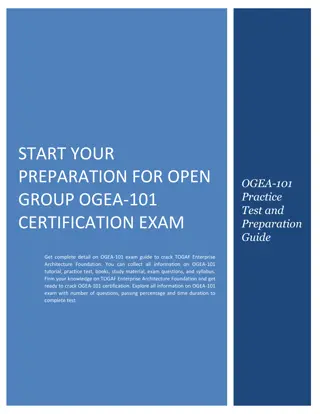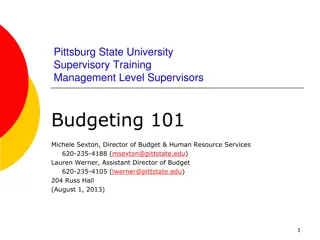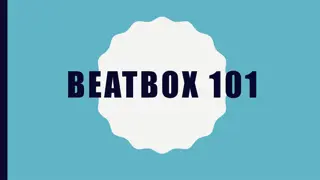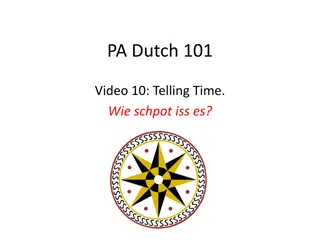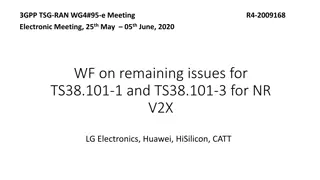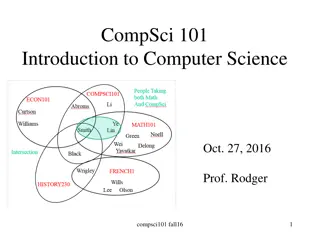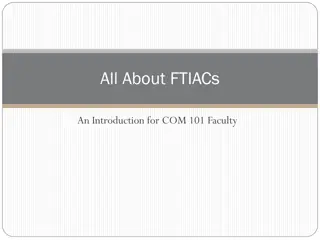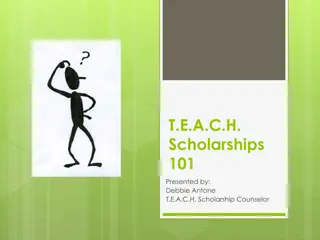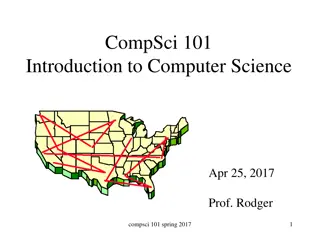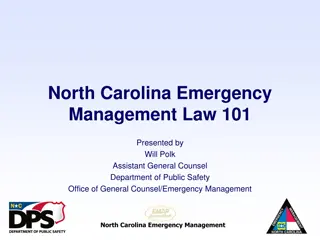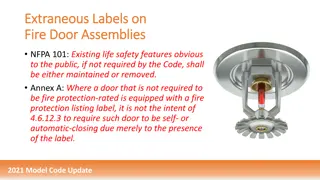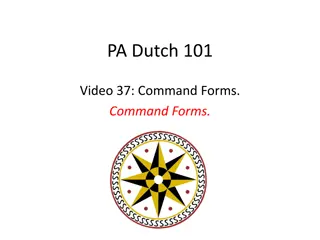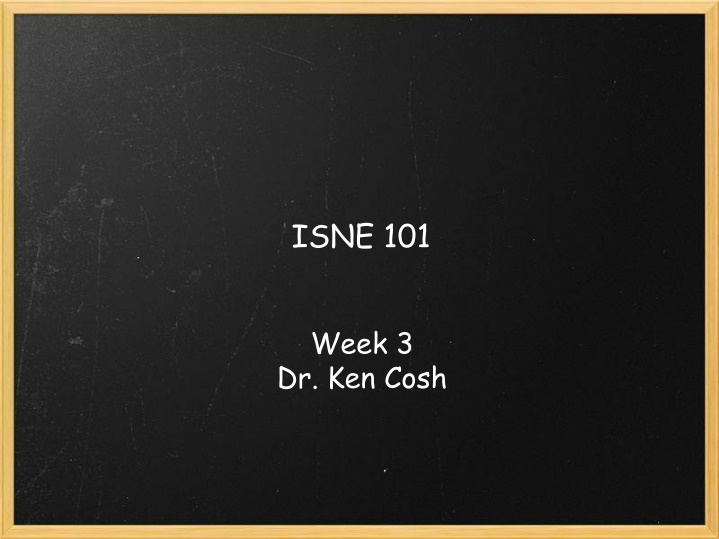
Evolution of Communication: From Speech to Writing and Networks
Explore the evolution of communication from the earliest forms of speech that set humans apart from animals to the development of writing symbols and networks. Discover important laws in communication technology, challenges to existing theories like Metcalfe's Law, and assignments related to understanding communication dynamics in modern society.
Download Presentation

Please find below an Image/Link to download the presentation.
The content on the website is provided AS IS for your information and personal use only. It may not be sold, licensed, or shared on other websites without obtaining consent from the author. If you encounter any issues during the download, it is possible that the publisher has removed the file from their server.
You are allowed to download the files provided on this website for personal or commercial use, subject to the condition that they are used lawfully. All files are the property of their respective owners.
The content on the website is provided AS IS for your information and personal use only. It may not be sold, licensed, or shared on other websites without obtaining consent from the author.
E N D
Presentation Transcript
ISNE 101 Week 3 Dr. Ken Cosh
Recap Last week we talked about binary. And hence encoding things into a binary form - digitisation! Remember Huffman? This Week Communication and Networks
Important Laws Moore s Law oPerformance doubles every 18-24 months, while costs stay the same. Metcalfe s Law oThe usefulness of a network increases with the square of the number of users connected to the network.
Assignment! Metcalfes Law is Wrong! https://spectrum.ieee.org/computing/networks/metcalfes -law-is-wrong Read the above article, and write a brief summary (max 1 page). Group A: 631615041 MAETHASITH TRIWUTPIPATKUL 640615018 TEEWARA KAPHEAK 640615013 NATAKORN THAMMATIWAT 640615011 CHAYUT RIANPRAKAISANG Group B: 640615025 640615024 631615045 640615023 SITTIPAT WEERAPAT WATHANYU PISIT PALAWOOTH KETWANG TRAGOONRATTANAMUTCHA PISUTTIPUNPONG
Assignment Group C: 630615021 NUTTAPONG 640615014 NATTHARIKA 631615044 ROBERT 640615015 NEERANUCH INKAEO PLONGNAK GREGORY SEETHIKHAM Group D: 640615030 NITISAT 640615504 HANCHUN 640615016 TANUTCHA 630615036 PHEERAWADEE DUANGSAENG WANG RINKAEW CHANTAKHAT Group E: 640615010 JUTHALAK 640615020 PREMCHIT 640615026 ARAYAWAT 640615012 CHINNAWAT WILAISON KORSRIPONR HAINAK SERMSUKRUNGSAKUN Group F: 640615021 PIMMADA 631615006 JIRAPINYA 640615017 TEERAWIT 640615019 PARIPAT KLUMWILAI SANPAPAO SINSASAI YUANSEE
Speech Sets Humans apart from animals Estimated 1.5million-200,000 years ago Mutation of the FOXP2 gene Facilitated transfer of knowledge through generations Forms the basis of written languages.
Progress towards Writing Symbols Allow message longevity but represent speech acts Cave Paintings Oldest date from around 30,000 BC Petroglyphs Around 10,000 BC carving developed to make incisions into rock surface Pictograms While Petroglyphs show a single scene, Pictograms narate a story Ideogram Ideograms represent concepts such as emotions
Writing Around 2-3,000 BC the Sumerians developed the first writing system. Evolved from Pictograms Developed into Cuneiform Around 1,000 characters -> 400 characters (Hittite Cuneiform) Symbols pressed into clay Egyptian Hieroglyphs were derived from Sumerian writing. "It is a complex system, writing figurative, symbolic, and phonetic all at once, in the same text, the same phrase, I would almost say in the same word." (Champollion)
Developing an Alphabet Egyptian Hieroglyphics were logosyllabic, i.e. symbols stand for; Words Sounds or to place a word in a category The Phonetic components of Hieroglyphs were crucial to developing an alphabet. The Egyptians developed a set of 22-24 Hieroglyphs which were used to record foreign names etc.
Proto-Sinaitic Also known as Proto-Canaanite Around 2,000-1,700 BC Migrant workers translated Egyptian Hieroglyphs into the Canaanite language E.g. The Egyptian "Pr" (or Per), meant house (or Floorplan). This became "bayt", which was Canaanite for house. Acrophony is when a letters name begins with the letter itself. Bayt ---> "Bet" ---> "Beta" ---> "B"
The Greeks Vowels were a hindrance when writing in Pheonician, (as well as Egyptian / Hebrew). But in Greek they were essential, and afforded equal status as consonants. Together with the "Latins" (Romans) the alphabet evolved into this! Other tribes evolved their alphabets differently, but most stem from the Proto-Sinaitic.
Communication Technology? What technology have we discussed so far?
The Printing Press 105AD - Chinese invent paper The Chinese also developed wood-block printing, and books with hard covers and movable type (circa. 1041). However, Chinese has thousands of characters, so traditional block printing was still preferred. ~1440 - Gutenburg 'invented' the printing press Ability to mass print books. Whereas before it could take a monk 20 years to transcribe the bible Gutenburg combined a variety of mechanical technologies to perfect his invention.
The Printing Press Gutenburg was named #1 person of the millennium by A&E Network & Time Life. Ahead of; Christopher Columbus Galileo Galilei Shakespeare Newton Da Vinci Freud Einstein Lincoln Darwin Beethoven Why did this technology invention have such a great impact?
Telecommunication Transmission of signals over a distance, for the purpose of communication. Visual, Audio (and later electronic) Fires Beacons Smoke Signals Drums Horns
Telecommunication The Problem: How do we use fires / beacons / smoke signals to send a message; Consider the fire beacons in Lord of the Rings. N0 FIRE = No Problem FIRE = Problem! The Solution: Semaphore
Hydraulic Telegraph Circa 400BC
Semaphore France 1792. 2*2m long arms with 7 positions 1*cross bar with 4 angles 7*7*4 = 196 196 different symbols 556 stations following line of sight Total distance 4,800km Paris to Lille = 15 stations / ~32 mins
Semaphore Sweden --> UK Germany -->
Electrical Telegraph The presence and flow of charge Electrons & Protons Very Fast Early versions used a grid like this-> Later Morse invented his code. This pre-dates Optical Semaphore
Electrical Telegraph Requires 'wires', which is a problem particularly at wartime. Maxwell: "We have strong reason to conclude that light itself is an electromagnetic disturbance in the form of waves propagated through the electromagnetic field." Marconi demonstrated that communication is possible wirelessly
Telephone, Television... 1876: Bell demonstrated the telephone Now the wires can talk. Combine this with Marconi, and the airwaves start to sing - we have radio. Add some pictures & we have a TV.
Telecommunication Systems Comprised of Hardware and Software arranged to transmit data from one location to another. oEstablish interface between sender and receiver oRoutes messages (packets) along most efficient paths oBasic information processing to make sure the right message gets to the right receiver oBasic editorial tasks, rearranging format, checking for transmission errors oConverts message speeds (from slower cable to speed of computer). oControls flow of information through a network.
Packet Transfer To improve the efficiency of a network, data streams are broken into packets. Packets are smaller bundles of data. Packets are different sizes dependent on the protocol or standard being used the X.25 packet switching standard uses packets sized 128bytes.
Protocols With telecommunications systems using a wide variety of diverse devices, a common set of rules are needed to enable them to talk to each other. The set of rules is called a Protocol. oTCP/IP oFTP oWAP oHTTP Each device identifies the receivers protocol so they can send data in the right way, and to check it arrived without problem.
Layered Protocols TCP/IP consists of many protocols, which are divided into layers; Application Layer Includes things like Bittorrent, DNS... Transport Layer Primarily tasked with forming data packets, adding header information etc. Internet Layer Includes IP, functions such as addressing / routing Link Layer Deals with actual data exchange, error checking, Bit Rate etc.
Internet Protocol Every PC / Printer etc. has a unique IP address. oIP addresses represent a 32 bit word But, this is translated to decimal-dot notation to make life easier! More like a phone number. o172.17.28.143 oEach number is between 0 and 255 (i.e. an 8 bit number in binary) Totally 256*256*256*256 different IP addresses = 4.3 Billion! Is that enough? Do we still need to remember the 4 numbers?
Internet Protocol There aren t enough unique addresses! oVarious clever ways have been developed to get around this Static vs Dynamic IP NAT hiding many IP addresses behind one IPv6 The next version of IP I can t remember my IP address! oThe DNS means we don t need to Domain Name Server / Service (DNS) A further translation of the IP address into Natural Language BELTA or KCOSH or Kitchen PC or www.bbc.co.uk
Twisted Pair Wire + Thin & Flexible cable + Cheaper than other cables
Coaxial Cable Commonly used for Video links Semi conductor surrounds copper wire to protect signal strength
Fibre Optics Uses medium of light Very fast Flexible, but comparatively expensive
Network Topology 1 Centralised Network oClose control oInefficient oSingle point of failure oLimited by central node capacity
Network Topology 2 Decentralised Network oGreater Admin Burden oWeakened Control oGreater Efficiency oRobust
Network Topology 3 Distributed Network (P2P) oShortest Route Efficiency oMultiple Route Efficiency oInfinitely Scalable oRobust oCongestion Backbone capacity oAdmin Difficulties Standards and Policies
Increasing Network Bandwidth Reliance on the backbone the red lines. Focus on Improving the speed, capacity and quality of network backbone oFor example; Trans Atlantic, connecting Europe with US.
Wireless Connection? Still a need for Fibre optics oWireless connection connects to another machine which is part of the network. oWIFI, Bluetooth Use Radio transmission to connect to an antennae like a walkie talkie! The antennae connects through a router to the network oIrDA Uses infra red to transmit between equipment oThe receiver then connects to the rest of the internet.
Routing Router oChooses the best route through the network for each data stream to take. oDifferent packets can take different routes. We can use Tracert to find out which route we are taking
Caching Caching developed to speed information transfer. oIf I want to download the football scores from BBC website. oMaybe so does my friend John etc. oRather than us all connecting to BBC, via US, once I ve downloaded the information, we can share it. oIt is stored in a cache
The Future? Faster Cables More Wireless Antennae s More interfaces / devices Cheaper connections Better reliability


